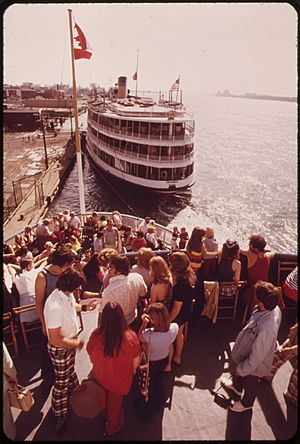SS Columbia facts for kids

Columbia around 1905. This picture helped her get listed on the National Register of Historic Places.
|
|
| History | |
|---|---|
| Name | Columbia |
| Launched | 1902 |
| In service | 1902 |
| Out of service | 1991 |
| Status | under restoration |
| General characteristics | |
| Tonnage | 968 (gross) 549 (net) |
| Length | 207.67 ft (63.30 m) |
| Beam | 45 ft (14 m) |
| Draft | 12.5 ft (3.8 m) |
| Depth | 17.79 ft (5.42 m) |
| Propulsion | Triple-expansion reciprocating steam engine |
|
Columbia (Excursion Steamer)
|
|
| Location | Buffalo, New York |
| Area | less than one acre |
| Built | 1902 |
| Architect | Frank E. Kirby |
| NRHP reference No. | 79001171 |
| Significant dates | |
| Added to NRHP | 2 November 1979 |
| Designated NHL | 6 July 1992 |
The SS Columbia is a special old ship. It's the very last excursion steamship left from the early 1900s. An excursion steamship is a large boat that takes people on fun trips, often to parks or islands. Her sister ship, the SS Ste. Claire, was the second to last, but it was damaged in a fire in 2018. Both ships were designed by Frank E. Kirby and Louis O. Keil.
The Columbia is so important that it was added to the National Register of Historic Places in 1979. This list includes places and things that are important to American history. In 1992, it was given an even higher honor: it became a National Historic Landmark. This means it's one of the most important historic places in the United States. As of 2019, the ship is in Buffalo, New York, where people are working hard to fix it up.
The Ship's Amazing History
The Columbia was built in Wyandotte, Michigan, in 1902. Its sister ship, Ste. Claire, was built a bit later in 1910. The ship's designer, Frank Kirby, created a new way to build the Columbia. This allowed for a huge open space inside, making it the first steamboat in the United States with a proper ballroom for dancing! The Columbia's design was so good that it influenced many other excursion steamers built later.
For many years, the Columbia and Ste. Claire sailed down the Detroit River from Detroit to Bois Blanc Island. This island in Canada had a fun amusement park built just for people who came on these ships. In the summer, the ships' three decks would be full of happy passengers. They enjoyed the 90-minute, 18-mile boat ride to the Boblo Island Amusement Park. Both ships had music, dancing, an arcade, and a snack bar. These ships became famous on the Detroit River and were loved by people in Detroit and Windsor, Canada.
The Columbia was also part of an important moment in history in 1945. A young African American woman named Sara Elizabeth Ray was on a graduation cruise aboard the ship with her classmates. However, people from the Boblo Excursion company told her she had to leave because of her race. When they threatened to remove her, she left but made sure to get their names. Sara Ray got help from the NAACP, a group that fights for civil rights. They filed a complaint against the company for unfair treatment. The company tried to say they didn't have to follow Michigan's laws because their trips crossed the border into Canada. But Michigan won in court, and eventually, the U.S. Supreme Court agreed, saying that the company could not discriminate.
Saving the Ship: Restoration Efforts
Over time, fewer people visited Boblo Island. In 1990, the company that owned Boblo Island said the ships were too expensive to keep. So, 1991 was the last summer for the Columbia and Ste. Claire. They were sold in 1991. In 1993, Boblo Island amusement park closed down. The ships were left docked in Ecorse, Michigan, where they were exposed to harsh winters. By 2000, both ships were in bad shape, with chipped paint, rotting wood, and holes in their decks.
In 2004, a group tried to protect the Columbia by wrapping it up like a giant package. They hoped to buy and fix it. However, they couldn't afford it. Later in 2006, a non-profit group from New York, called "The S.S. Columbia Project," took over. Their goal was to restore the ship and use it for educational trips and tours on the Hudson River.
Their plan was to raise money to fix the ship, and then use the money from tickets and tours to keep it running. They imagined daily trips from Manhattan to towns along the Hudson River.
The Columbia and Ste. Claire were even used in the 2014 movie Transformers: Age of Extinction. They were changed temporarily for the film.
In September 2014, the Columbia was moved from Detroit to Toledo, Ohio, for repairs in a dry dock. This was to get it ready for its big move to New York. In September 2015, it was moved to Buffalo, New York. It is still there, being prepared for its journey to the Hudson River.
The music video for the 2017 song "Score The Sky" by the band Lost Horizons was filmed in part on the SS Columbia.
Images for kids






